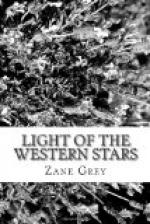She went on to tell that the climate was mild in winter and hot in summer. Warm, sunshiny days prevailed nearly all the year round. Some summers it rained, and occasionally there would be a dry year, the dreaded ano seco of the Mexicans. Rain was always expected and prayed for in the midsummer months, and when it came the grama-grass sprang up, making the valleys green from mountain to mountain. The intersecting valleys, ranging between the long slope of foothills, afforded the best pasture for cattle, and these were jealously sought by the Mexicans who had only small herds to look after. Stillwell’s cowboys were always chasing these vaqueros off land that belonged to Stillwell. He owned twenty thousand acres of unfenced land adjoining the open range. Don Carlos possessed more acreage than that, and his cattle were always mingling with Stillwell’s. And in turn Don Carlos’s vaqueros were always chasing Stillwell’s cattle away from the Mexican’s watering-place. Bad feeling had been manifested for years, and now relations were strained to the breaking-point.
As Madeline rode along she made good use of her eyes. The soil was sandy and porous, and she understood why the rain and water from the few springs disappeared so quickly. At a little distance the grama-grass appeared thick, but near at hand it was seen to be sparse. Bunches of greasewood and cactus plants were interspersed here and there in the grass. What surprised Madeline was the fact that, though she and Florence had seemed to be riding quite awhile, they had apparently not drawn any closer to the round-up. The slope of the valley was noticeable only after some miles had been traversed. Looking forward, Madeline imagined the valley only a few miles wide. She would have been sure she could walk her horse across it in an hour. Yet that black, bold range of Chiricahua Mountains was distant a long day’s journey for even a hard-riding cowboy. It was only by looking back that Madeline could grasp the true relation of things; she could not be deceived by distance she had covered.
Gradually the black dots enlarged and assumed shape of cattle and horses moving round a great dusty patch. In another half-hour Madeline rode behind Florence to the outskirts of the scene of action. They drew rein near a huge wagon in the neighborhood of which were more than a hundred horses grazing and whistling and trotting about and lifting heads to watch the new-comers. Four cowboys stood mounted guard over this drove of horses. Perhaps a quarter of a mile farther out was a dusty melee. A roar of tramping hoofs filled Madeline’s ears. The lines of marching cattle had merged into a great, moving herd half obscured by dust.
“I can make little of what is going on,” said Madeline. “I want to go closer.”
They trotted across half the intervening distance, and when Florence halted again Madeline was still not satisfied and asked to be taken nearer. This time, before they reined in again, Al Hammond saw them and wheeled his horse in their direction. He yelled something which Madeline did not understand, and then halted them.




